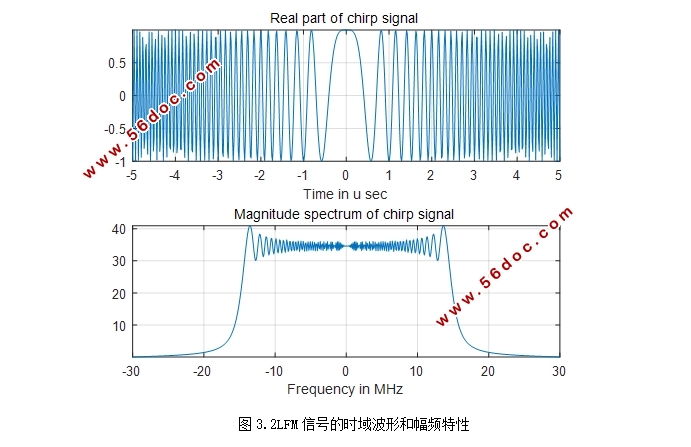非平稳线性调频信号的检测与估计(论文12000字)
摘要:当一个信号的分布律和分布参数会跟随时间的变化而变化时,我们就称之为非平稳信号。常见的有平稳随机信号和非平稳随机信号,我们一般用三种方法分析它,例如,时域和频域分析以及时域和频域联合在一起来分析。非平稳随机经过一系列的统计与研究,可以发现它是一个关于时间的函数。自从非平稳信号的研究开展以来我们主要用概率以及数字特征来描述这种信号。但是相关函数和时变谱用于工程上的研究与应用,21世纪以来又提出了新的信号模拟描述的方法,如时间参数信号模拟法。
作为广泛应用的非平稳信号之一的线性调频(LFM)信号,在各个工程领域内都有非常重大的实用意义。非平稳线性调频信号,有着十分成熟的低截获概率性质,如今在各个方面的雷达应用里占据不可替代的位置。正是这个原因,我们把有用的信息从LFM信号中提取出来,然后对线性调频(LFM)信号的各个参数进行检测和估计,对于工程方面的应用和理论方面的研究分析具有十分重大的意义。自信号方面研究的发展以来,国内外研究者们对于信号的检测和估计方面开展了深入钻研,并且在估计信号参数的理论上总结了很多重要的研究成果,但是这是远远不够的,对于非平稳信号的检测与估计依旧在不断完善的过程中。本文采用传统的时域相关性来获得回波信号的时延,在分析检测线性调频(LFM)信号的分数傅里叶变换(FrFT)方法的性质和特征的同时,进行了改进,形成了一种新的方法:分数频域相关法。我们利用这种方法,可以检测回波LFM信号,并且还可以准确地估计多普勒频移。 由于已知的条件,不需要在二维空间中搜索旋转角度,这是简单且高效的。 仿真结果表明了该方法的有效性。
关键词:非平稳,线性调频信号,参数估计,基本原理,宽带,低信噪比,FrFT
Parameter detection and estimation for Linear Frequency Modulation Signal
Abstract:: When the distribution law and distribution parameters of a signal change with time, we call it a non-stationary signal. There are stationary random signals and non-stationary random signals in random signals. We generally analyze them in three ways, for example, time domain and frequency domain analysis, and time domain and frequency domain are combined to analyze. Non-stationary randomization After a series of statistics and studies, the function of time is its statistical properties. This is similar to the statistics of stationary signals. We have traditionally described non-stationary signals with probabilities and numerical features, but correlation functions and time-varying spectra are used in engineering research and applications. The signal simulates a method of description, such as a time parameter signal simulation.
The linear frequency modulation (LFM) signal, which is one of the widely used non-stationary signals, has great practical significance in various engineering fields. Non-stationary chirp signals, with their very mature low probability of interception, now occupy an irreplaceable position in all aspects of radar applications. It is for this reason that we extract useful information from the LFM signal, and then detect and estimate the parameters of the linear frequency modulation (LFM) signal, which is of great significance for engineering applications and theoretical research.ince the development of signal research, researchers at home and abroad have conducted in-depth research on signal detection and estimation, and summarized many important research results in the theory of estimating signal parameters, but this is far from enough. The detection and estimation of non-stationary signals is still in the process of continuous improvement. In this paper, the traditional time domain correlation is used to obtain the delay of the echo signal. While analyzing the properties and characteristics of the Fractional Fourier Transform (FrFT) method for detecting the linear frequency modulation (LFM) signal, it is improved and formed a new method: fractional frequency domain correlation method. Using this method, we can detect the echo LFM signal and also accurately estimate the Doppler shift. Due to the known conditions, it is not necessary to search for the angle of rotation in a two-dimensional space, which is simple and efficient. Simulation results show the effectiveness of the proposed method.
Key words: non-stationary signal,Chirp signal, parameter estimation, basic principle, wideband, low signal to noise ratio,FrFT

目录
1.绪论 5
1.1研究背景及意义 5
1.2研究现状 5
1.3论文安排 6
2.非平稳信号及时频分析 6
2.1 非平稳信号 6
2.2时频分布的基本性质 6
2.3不确定性原理 7
2.4 短时傅里叶变换 8
2.5 Winger-Ville分布 8
3.线性调频信号的FrFT检测基本原理 12
3.1非平稳线性调频信号(LFM) 12
3.1.1 LFM信号的形式及原理 12
3.1.2 LFM 信号仿真 13
3.2 FrFT检测线性调频信号的基本原理 14
3.3 FRFT的数值计算 14
3.4基本思路和方法 15
4.分数阶域相关LFM信号检测与估计 16
4.1.LFM信号模型和二元假设检验模型 16
4.2分数频域的相关性及时域相关性 16
4.2.1时域相关性 16
4.2.2分数频域的相关性 17
4.3方法的基本流程 19
4.4 计算机仿真与结果分析 20
5.总结 22
6.参考文献 22
致谢 23
|



